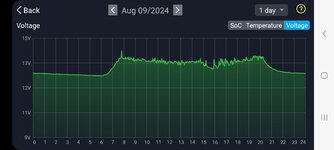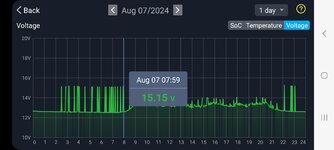Hi. We have a swift 696 with original sargent electrical systems fitted and what we believe to be a 60w roof fitted solar panel. When we go off grid we also use a portable solar panel which has so far all been adequate for our off grid usage.
I recently bought a couple of bm6 battery monitors to try and help me monitor/understand whats going on with the batteries. Whilst in storage and with the psu turned off and without ehu, the readings from the leisure battery are as I would expect. Theres no solar going into it and over 3 weeks, the soc has dropped a little.
The vehicle battery on the other hand has me totally confused. During the day, it fluctuates depending on the conditions/sun but on some days during the night when no solar available it seems to spike for no (to me) apparent reading.
I've attached screenshots from 2 different time periods if anybody can help me understand what might be going on with my vehicle battery I would be grateful for your observations.


I recently bought a couple of bm6 battery monitors to try and help me monitor/understand whats going on with the batteries. Whilst in storage and with the psu turned off and without ehu, the readings from the leisure battery are as I would expect. Theres no solar going into it and over 3 weeks, the soc has dropped a little.
The vehicle battery on the other hand has me totally confused. During the day, it fluctuates depending on the conditions/sun but on some days during the night when no solar available it seems to spike for no (to me) apparent reading.
I've attached screenshots from 2 different time periods if anybody can help me understand what might be going on with my vehicle battery I would be grateful for your observations.




